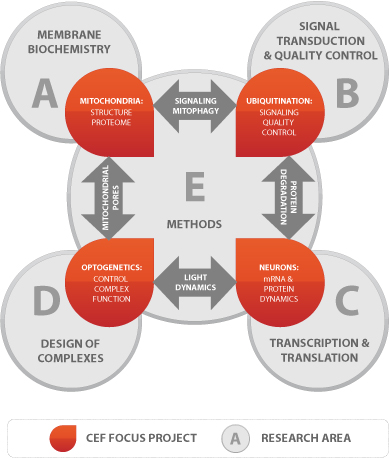Overview
In the Cluster of Excellence Frankfurt “Macromolecular Complexes” (CEF) international teams of scientists investigated the structure and function of large macromolecular complexes, in particular membrane proteins and their assemblies, complexes involved in signal transduction and quality control and RNA-protein complexes. CEF was established in 2006 by Goethe University together with the Max Planck Institutes of Biophysics and Brain Research. CEF grew out of the long-standing collaborative research on membrane proteins and RNA molecules. CEF strengthened research efforts in these fields by recruiting further excellent scientists to Frankfurt. Following a successful proposal to the Wissenschaftsrat for a new research building, CEF founded the Buchmann Institute for Molecular Life Sciences (BMLS), a state-of-the-art research facility which houses research groups from four faculties of the University. CEF enhanced the technological infrastructure in Frankfurt by purchasing new instrumentation. The Frankfurt Center for Advanced Light Microscopy and the Frankfurt Center for Electron Microscopy are both located in the BMLS and were established by scientists recruited by CEF. The Cluster promoted scientific exchange through a range of programmes as well as through workshops, international conferences, lecture series and faculty dinners. CEF scientists published more than 2600 original research publications (incl. 479 research papers in journals with an impact factor of ≥10) during the Cluster’s lifetime. Important structures of macromolecular complexes have been determined in CEF. Examples for important membrane complexes include the atomic structures of complex I and the ATP synthase of the mitochondrial respiratory chain and of the antigen translocation complex TAP. Research on RNA structure and function led to the definition of regulatory principles of temperature sensing riboswitches, the structure-function relationship of RNA polymerase I, the functions of microRNAs and the mechanisms of rRNA maturation and downstream processes during ribosome biogenesis and recycling. For instance, CEF scientists identified the receptors of ubiquitin chains on the proteasome, deciphered the role of linear ubiquitin chains and described macromolecules regulating mitophagy, xenophagy and ER-phagy. They delineated the role of sumoylation in ribosome quality control and characterized the process of genetic quality control in oocytes. The efforts in these three research areas were accompanied by approaches to design or reprogram macromolecular complexes and new methods developed to expand the already strong expertise. CEF scientists established and advanced the principles of optogenetics as well as biochemical methods for light regulation. They also developed biophysical techniques for the structural and functional characterization of macromolecules. Example include light-switchable molecules designed for in-cell applications and time-resolved techniques to study RNA folding. Light sheet microscopy for the observation of development and LILBID mass spectrometry for the analysis of membrane complexes was improved. PELDOR-EPR was developed to a resolution that allows in-cell measurements.
The figure below describes the structure of CEF. Further information is provided under the individual research areas. The research publications can be accessed here and also a list of honours awarded during CEF.


